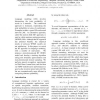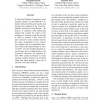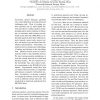ACL
2015
8 years 7 months ago
2015
Language modeling (LM) involves determining the joint probability of words in a sentence. The conditional approach is dominant, representing the joint probability in terms of cond...
ACL
2015
8 years 7 months ago
2015
We propose a novel method for translation selection in statistical machine translation, in which a convolutional neural network is employed to judge the similarity between a phras...
ACL
2015
8 years 7 months ago
2015
Patterns extracted from dependency parses of sentences are a major source of knowledge for most state-of-the-art relation extraction systems, but can be of low quality in distantl...
ACL
2015
8 years 7 months ago
2015
Timeline generation is a summarisation task which transforms a narrative, roughly chronological input text into a set of timestamped summary sentences, each expressing an atomic h...
ACL
2015
8 years 7 months ago
2015
We propose a cross-lingual framework for learning coreference resolvers for resource-poor target languages, given a resolver in a source language. Our method uses word-aligned bit...
ACL
2015
8 years 7 months ago
2015
A defining symptom of autism spectrum disorder (ASD) is the presence of restricted and repetitive activities and interests, which can surface in language as a perseverative focus...
ACL
2015
8 years 7 months ago
2015
In Statistical Machine Translation, some complex features are still difficult to integrate during decoding and usually used through the reranking of the k-best hypotheses produce...
ACL
2015
8 years 7 months ago
2015
Answering natural language questions over a knowledge base is an important and challenging task. Most of existing systems typically rely on hand-crafted features and rules to cond...
ACL
2015
8 years 7 months ago
2015
In this paper, we demonstrate a system implementation of a framework for computer assisted pronunciation training for second language learner (L2). This framework supports an iter...
ACL
2015
8 years 7 months ago
2015
The path ranking algorithm (PRA) has been recently proposed to address relational classification and retrieval tasks at large scale. We describe Cor-PRA, an enhanced system that ...



